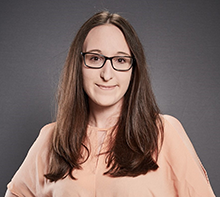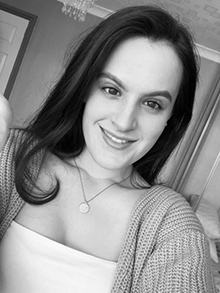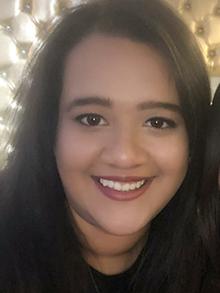‘Most promising science’ prizes at Annual Conference 2021: Journal of General Virology winners
Posted on June 17, 2021 by Laura Cox
Over the week at Annual Conference Online 2021, delegates showcased excellent posters and exciting research. We are very pleased to announce the winners of the Microbiology Society Journals ‘Most Promising Science’ prizes. In this blog, we will find out more about some of the winners awarded the prize by Journal of General Virology Editors.
Anzelika Rubina: "HCMV UL148 and UL148D regulate multiple immune pathways by impairing expression of ADAM17"
Who or what inspired you to be a scientist?
My biology teacher inspired me to become a scientist. She was very passionate about science and research. She found all the advances in the fields of molecular biology and biotechnology truly fascinating, and she would always say that if she were younger, she would do a degree in molecular biology.
What are you currently working on and what area of your research excites you the most?
I’m currently trying to decipher a complex mechanism that human cytomegalovirus (HCMV) employs to manipulate one of the main cellular regulators – the protein ADAM17. ADAM17 has a very well-established role in many cellular processes, however its regulation remains poorly understood. Studying how HCMV manipulates ADAM17 will shed some light on important ADAM17 biology.
How would you explain your poster to a child under 10?
Have you ever had a cold, or the flu? It is because you were infected with a virus. Viruses are tiny germs that can get inside a person's body and make them sick. I study how viruses do that, so that we can make medicine to treat viral diseases.
What would you be doing in your career if you weren’t a scientist?
If I wasn’t a scientist, I think I would be a dietician or nutritionist. I always found interest in food, nutrition and a healthy lifestyle. Foods that we eat have a huge impact on our physical and mental health and I developed an appreciation for that when I was a teenager.
Kerry Newbrook: “Virus damage or host response? Elucidating mechanisms of pathogenesis in bluetongue virus-infected sheep”

Who or what inspired you to be a scientist?
Definitely the animals themselves! I’ve always loved animals and being a scientist in veterinary infectious disease research means I can work towards improving their welfare in addition to satisfying my craving to understand how things work. I absolutely love investigating new ideas and making new discoveries!
What are you currently working on and what area of your research excites you the most?
I am currently a postdoctoral scientist at The Pirbright Institute working in the Orbivirus Research group to develop novel diagnostic serological assays for bluetongue virus (BTV) and investigating anti-BTV immune responses in infected vs vaccinated cattle and sheep. I have a real passion for research into host-pathogen interactions and disease pathogenesis.
How would you explain your poster to a child under 10?
Sometimes farm animals like sheep and cows get sick and to stop more getting sick, scientists like me monitor these sick sheep to understand what is happening and create medicines to stop other farm animals getting sick. We look at how sick the sheep get and how they defend themselves.
What would you be doing in your career if you weren’t a scientist?
I absolutely love baking and so if I wasn’t a scientist I would probably own my own bakery!
Megan McConnell: “The mutational variety of the live-attenuated influenza vaccine proteome”

Who or what inspired you to be a scientist?
I was inspired to study microbiology at university because I have always been interested in germs and bacteria from a young age. By following my own interests this got me into parasitology at high school. I choose to study microbiology at university due to my wide interests and have specialised in virology.
What are you currently working on and what area of your research excites you the most?
This year I have finished my honours dissertation on antibiotic resistance genes and Clostridium difficile and this was exciting as both this bacterium and antibiotic resistance are a particular issue globally today.
How would you explain your poster to a child under 10?
My poster is about flu which you might have heard of when you get the flu nasal spray in your nose. Flu is able to change its shape and make you sick. I looked to see where flu changes and if these were good or bad.
What would you be doing in your career if you weren’t a scientist?
If I wasn’t studying microbiology, I would be studying to become a midwife as it is a very rewarding career.
Nazia Thakur: “The SARS-CoV-2 Spike protein has a broad tropism for mammalian ACE2 proteins”

Who or what inspired you to be a scientist?
I think the teaching I had during the final year of my undergraduate degree inspired me to become a scientist. I also really enjoyed my first lab experience and seeing the knowledge, passion, and dedication of my supervisor to their work really stuck with me and made me want to continue doing research.
What are you currently working on and what area of your research excites you the most?
I started my PhD in September 2020, and my research question focuses on determining whether pre-existing immunity can confer cross-protection against infection from related viruses (Henipaviruses and Coronaviruses). Being able to combine both my love for immunology and virology really excites me about my research!
How would you explain your poster to a child under 10?
We were trying to look at whether SARS-CoV-2, the virus that causes COVID-19, can infect other animals. This is important because these animals could get sick or pass the virus back to people. As SARS-CoV-2 is thought to have originated in bats, we also wanted to see what changes in the virus allowed it to infect humans.
What would you be doing in your career if you weren’t a scientist?
I really enjoy doing creative things like drawing, painting, baking and art and crafts in my spare time, so I think I’d probably have liked to be a baker and decorator! The lab I’m currently working with are basically the chief tasters of my bakes – no complaints so far!
Olivia Swann: “Visualising influenza cRNAs reveals a role for ANP32 in vRNA to cRNA synthesis’’

Who or what inspired you to be a scientist?
Lots of different things but mainly my parents and school.
What are you currently working on and what area of your research excites you the most?
I’ve spent a lot of my PhD developing an RNA FISH approach to visualise flu replication products so am most excited to be using this tool to answer interesting questions about flu replication! At the moment I am mainly using it to investigate the role of host factor ANP32.
How would you explain your poster to a child under 10?
Viruses are a bit like tiny robots that get into our bodies’ cells and sneakily change them into factories to make more robots. My work lets us see parts of the tiny new ‘robots’ as they get made so we can investigate how this works – and hopefully lets us find new ways to stop them!
What would you be doing in your career if you weren’t a scientist?
I love plants, books and cats, so preferably something combining the three!

